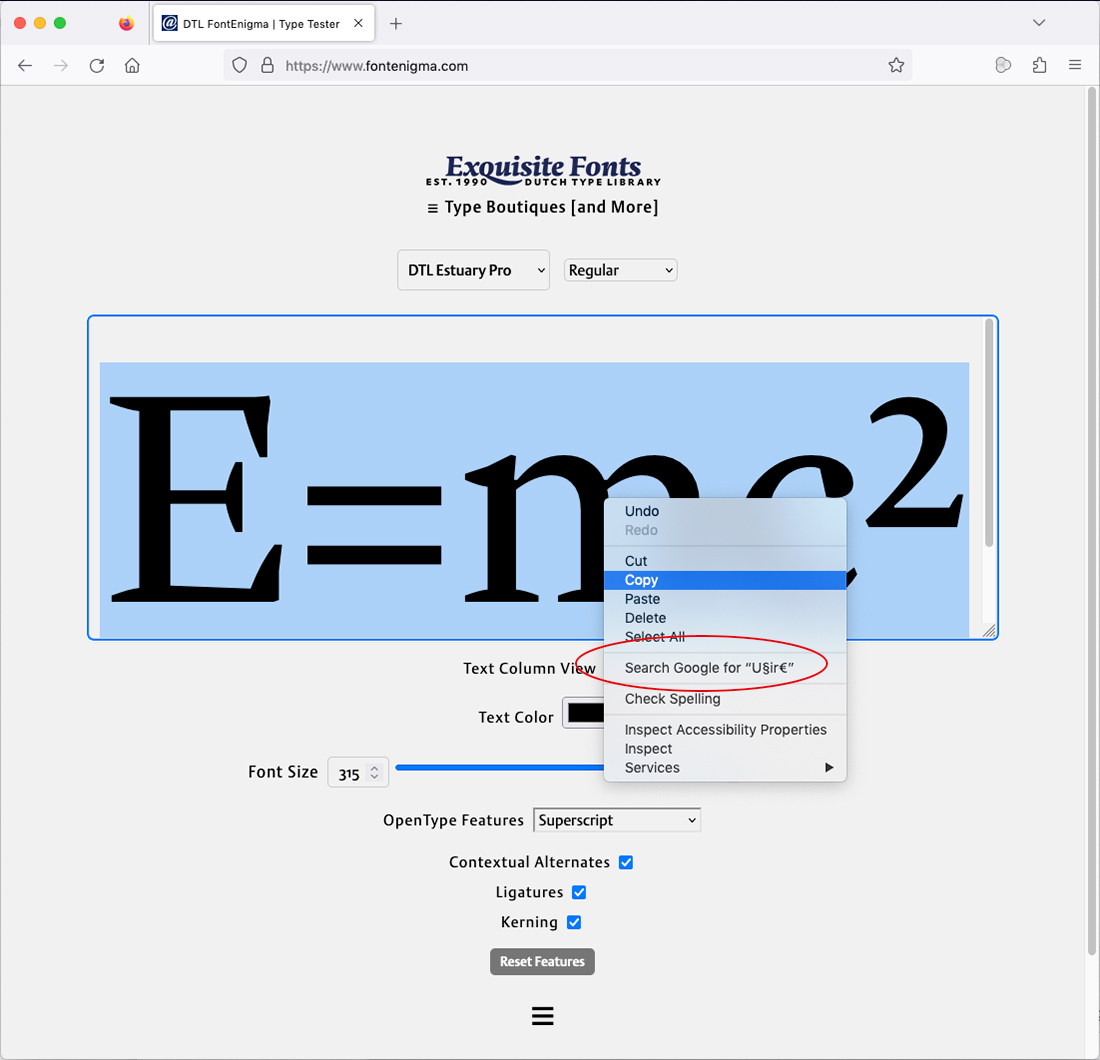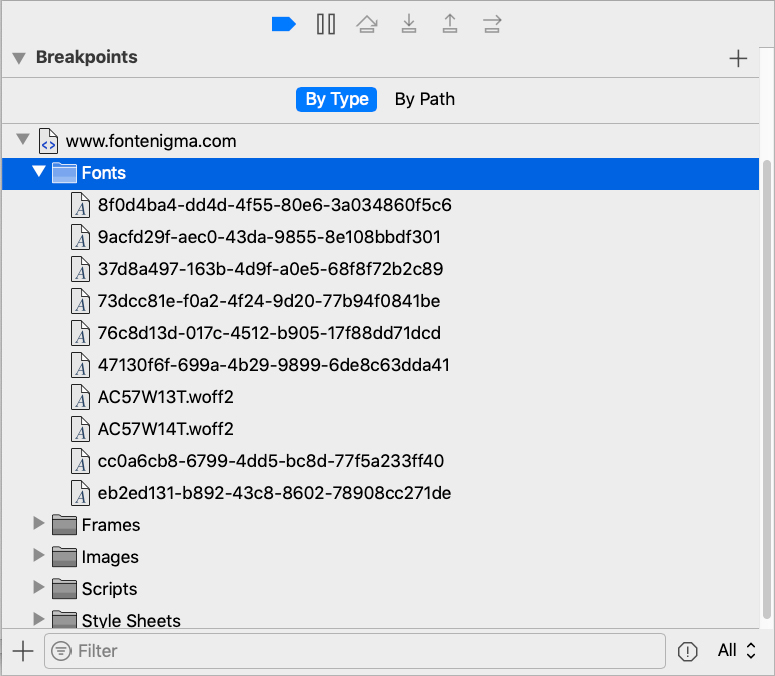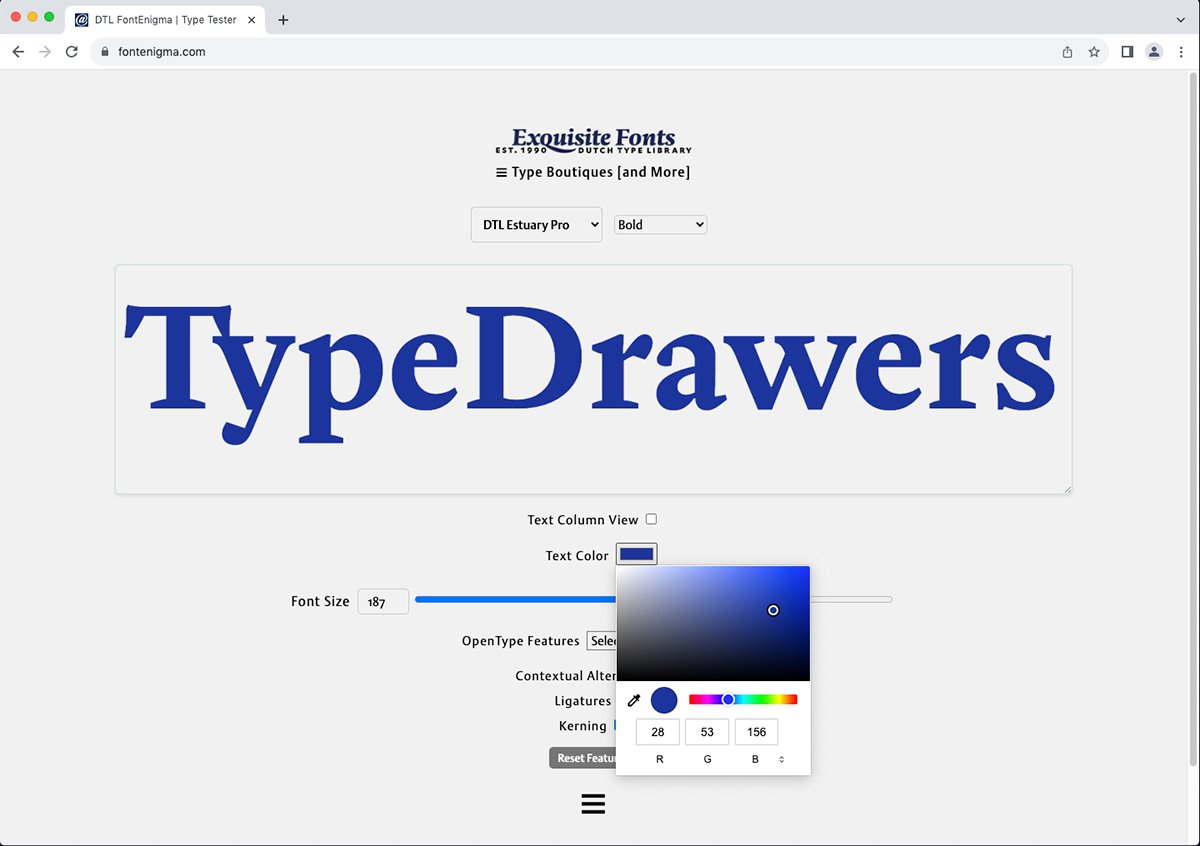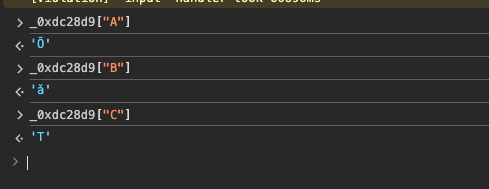FontEnigma
Comments
-
If you need to preserve the entered text so that it is available for copy-pasting, here's an idea that came to mind – with duplicating the text element – one for typing the text and one for displaying the font.if you type the alphabet in one direction, the obfusction in the opposite direction will become clear when you copy the result into a text editor. Evib~dvoo~hklggvw}
Here is the link to a test layout. Green cursor is the upper (operable) element – here you see only cursor. Blue text is the lower element with displayed font – the text is copied here with JavaScript.
https://jsfiddle.net/4p8zgfhx/
Explanation.
Place two text elements above each other (absolutely positioned inside the container), with the same font size and line height (to synchronise the caret position). Lower text element is the rendered font with obfuscation, that user will see. Upper text element is the transparent font without obfuscation (and with empty glyphs), that user operate. Top element should have transparent text but visible caret. Both fonts should have the same horizontal metrics (for displayed letter) to synchronise the caret. Then use JS to copy text from user-operable upper element to lower element.0 -
Simon Cozens said:Exactly. What does "protecting against the casual attacker" mean when the attack method of the casual attacker is to simply download the font from a web site where it's been provided by the sophisticated attacker?Well, one may not be able to protect against the sophisticated attacker cracking any technical means of copy protection one might be attempting to use with one's font.But one can certainly make use of things like DMCA takedown requests when one's cracked font is appearing on somebody's web site. That would be protection against the casual attacker.Another example of protecting against the casual attacker would be to insist that people using the font for a web site use some copy protection mechanism. However, my understanding is that these days the most commonly used browsers don't support copy protection for web fonts any longer; and back when they did, each browser supported a different scheme. Absent a means of copy protection, one just looks at the page source, then the CSS file source if necessary, and downloads the font, which is within the abilities of a casual attacker.0
-
There is a technique for loading a font as an encoded flow. It's good enough protection from a lazy attacker who just know how to save the file from a page cache (because now the font there is encoded), however it is still not a bulletproof approach. The problem is that the font customer (website owner) needs to do an extra steps for this (PHP, JS), and this is a huge stumbling stone. I would say, a stone unliftable for most. Not to mention that many people won't agree to the font not being stored in the cache but being dynamically loaded every time.John Savard said:However, my understanding is that these days the most commonly used browsers don't support copy protection for web fonts any longer; and back when they did, each browser supported a different scheme. Absent a means of copy protection, one just looks at the page source, then the CSS file source if necessary, and downloads the font, which is within the abilities of a casual attacker.
So all these discussed techniques can only give an initial effect on the font market / type tester website, until the font is purchased.But one can certainly make use of things like DMCA takedown requests when one's cracked font is appearing on somebody's web site. That would be protection against the casual attacker.Usually, by that time the font has already been downloaded many times, most of which occur in the first few days.
Another idea that requires some technical resources (startup for some enthusiasts) is to have a database of malicious addresses (where fonts are usually leaked) and automatically scan it regularly for certain font names. It sounds crazy, but who knows what the future holds. In a better world where governments were concerned about this, some anti-crime agency would be handling all of this. In a better world.0 -
Hi Michael, although I find it hard to imagine a scenario where users need to copy readable text from the type tester, maybe hiding the obfuscation at first sight would be useful, and implementing it should not be too difficult. The current version of FontEnigma (which uses a somewhat more complex obfuscation than the initial release) already translates pasted text on the fly. The reverse should also be possible by intercepting the copy event and replacing the selection with decoded text before it is written to the clipboard. I will give this a try in the near future.0
-
The latest version of FontEnigma now decodes text copied or cut from the type tester. So instead of getting obfuscated strings like ‘U§ir€’ when copying something like ‘E=mc²’, you now get the actual readable text as displayed.
 It might not be a game-changer, but it definitely makes things a bit neater and more user-friendly.0
It might not be a game-changer, but it definitely makes things a bit neater and more user-friendly.0 -
It might not be a game-changer, but it definitely makes things a bit neater and more user-friendly.And a lot easier to reverse engineer :-)
0 -
Yes, perhaps a little. However, basically this information was already available, as the submenu shows.0
-
In the latest version of FontEnigma, I have added a couple of things to help make it harder to grab the fonts or inspect the page easily.
 First, the browser’s context menu is disabled on desktop (both right-click and keyboard). On mobile it is still allowed, otherwise users would not be able to copy and paste text. The oncontextmenu event is also locked on the <body>, in case someone tries to override it.
First, the browser’s context menu is disabled on desktop (both right-click and keyboard). On mobile it is still allowed, otherwise users would not be able to copy and paste text. The oncontextmenu event is also locked on the <body>, in case someone tries to override it.
More importantly, the woff2 font files are now XOR-encrypted, and then decrypted on the fly in the browser using JavaScript. Once decoded, the fonts are loaded using FontFace and referenced via a temporary ‘blob:’ URL, which disappears as soon as the page is refreshed or closed.
I must admit, however, that all of this together only adds up to a small additional hurdle that a serious attacker can undoubtedly get around.1 -
In addition, the ‘blob;’ URL now expires immediately.0
-
As mentioned, the XOR‑encrypted fonts (for example ‘typeface.woff2.xor’) are decrypted on the fly in the browser. The resulting ‘blob:’ URLs are ephemeral: they disappear or are replaced when the page is refreshed or closed. The original font file paths and directory structure are never exposed to the page.
Keeping the original source paths hidden and limiting access are therefore the most important defenses. That said, if an attacker can observe the decrypted bytes (for example via DevTools, an instrumented browser, or a man‑in‑the‑browser attack), no purely client‑side measure can prevent extraction: this is, of course, an inherent limitation of rendering assets in the user’s browser. I would not be surprised if some of you managed to do that.
The XOR encryption I use is intentionally lightweight: with a 256‑bit (or larger) key it provides a practical layer of obfuscation for this use case. The primary goal is to make casual downloading and automated harvesting more difficult. That said, the encryption is relative: after all, in the browser at runtime the decrypted bytes exist in memory, even if extracting them is not straightforward.
The JavaScript involved is simple and lightweight as well. It is easily portable to any site and requires minimal changes to fonts‑related CSS. That makes it feasible to distribute the script together with encrypted webfonts to customers. Each customer receives a unique XOR key and the font files for that customer are encrypted with that key. Without the key the encrypted files are useless –unless the client code is cracked, of course.
Decryption and serving of the fonts is performed by that JavaScript, which we then heavily obfuscate. This adds friction but is a possible weakness too: obfuscation, no matter how elaborate, can be reversed. Cracking it, however, requires skill and patience, but it is possible. The key could be handled more securely (for example via server‑assisted, short‑lived keys), but that would require more server‑side work, and the design goal here is to keep client-integration simple.
Client-side decryption and the obfuscated script can slightly slow down page loading, but I reduce this impact by loading fonts asynchronously and using caching. The effect on user experience is minimal. The sizes of the font files stay the same after being XOR-encrypted.
In conclusion, customer-distributed font files include only XOR-based protection; the fonts themselves are not altered: Unicode codepoints and outlines remain intact. The DTL type tester, by contrast, applies an additional layer of font‑level obfuscation, since it exposes the full library for live rendering. These protections are designed to reduce the risk of unauthorized downloading and redistribution as much as possible, while keeping the fonts usable in their intended contexts.1 -
The latest version of FontEnigma is a bit faster and has a cleaner look. It also includes stronger Unicode obfuscation: the code points of 400 characters have been scrambled across the ranges used by the displayed fonts. This makes full reconstruction considerably harder after converting captured ASCII back to binary.
 The XOR encryption remains in place, but it mainly protects against a compromised server. As an aside, I have further hardened the site with additional nginx (reverse-proxy) and Apache rules. Penetration tests will likely still reveal minor, low-risk issues, because nginx’s proxying prevents those requests from reaching the top-level .htaccess file in Apache.0
The XOR encryption remains in place, but it mainly protects against a compromised server. As an aside, I have further hardened the site with additional nginx (reverse-proxy) and Apache rules. Penetration tests will likely still reveal minor, low-risk issues, because nginx’s proxying prevents those requests from reaching the top-level .htaccess file in Apache.0 -
I had to try :-)I was able to download the WOFF2 blob with the mixed up cmap. I set a breakpoint at the textarea's event handler. Stepping through the code showed where the input gets converted to the encoded output. You can then jump in the console and use the decoding-array to loop over the relevant characters to get their encoded variant. Updating the cmap in downloaded font accordingly would result in a working font, as far as I can tell. (edit: expanded a little on how I found the array)

I don't think any of that made if back to the server, did you see anything @LeMo aka PatternMan aka Frank E Blokland?0 -
Hi Roel, nice catch, and thank you for pointing that out. You are absolutely correct: updating the cmap accordingly would result in a functional font. Unfortunately, as far as I am aware, there is no way to prevent someone from setting a breakpoint using DevTools.0
-
Peter Constable said:FontEnigma makes the font data less appealing by making the font non-interoperable by using a custom encoding. The corollary is that it also makes the text non-interoperable. One implication is that a Web site will not work with accessibility tools such as screen readers, meaning it will not be compliant with WCAG or with the EU Accessibility Act, which goes into enforcement next month.I don't know the details of these laws. But if the obfuscation is applied not to the body of a web site, but simply to a sample of a typeface, as seems to be what is proposed, then the important information is what the typeface looks like, not the demonstration text.So you can read "Futura Semi-Bold" but not "Pack my box with five dozen liquor jugs".I cannot tell if that will not be construed as a violation, but one might think that it ought not to be.However, obfuscating a font by re-arranging characters, if you don't also omit the ones not used, still leaves the font open to piracy by a somewhat casual attacker who has a copy of FontForge.0
Categories
- All Categories
- 46 Introductions
- 3.9K Typeface Design
- 486 Type Design Critiques
- 563 Type Design Software
- 1.1K Type Design Technique & Theory
- 655 Type Business
- 859 Font Technology
- 29 Punchcutting
- 520 Typography
- 119 Type Education
- 324 Type History
- 77 Type Resources
- 112 Lettering and Calligraphy
- 33 Lettering Critiques
- 79 Lettering Technique & Theory
- 557 Announcements
- 94 Events
- 114 Job Postings
- 170 Type Releases
- 178 Miscellaneous News
- 276 About TypeDrawers
- 54 TypeDrawers Announcements
- 120 Suggestions and Bug Reports


